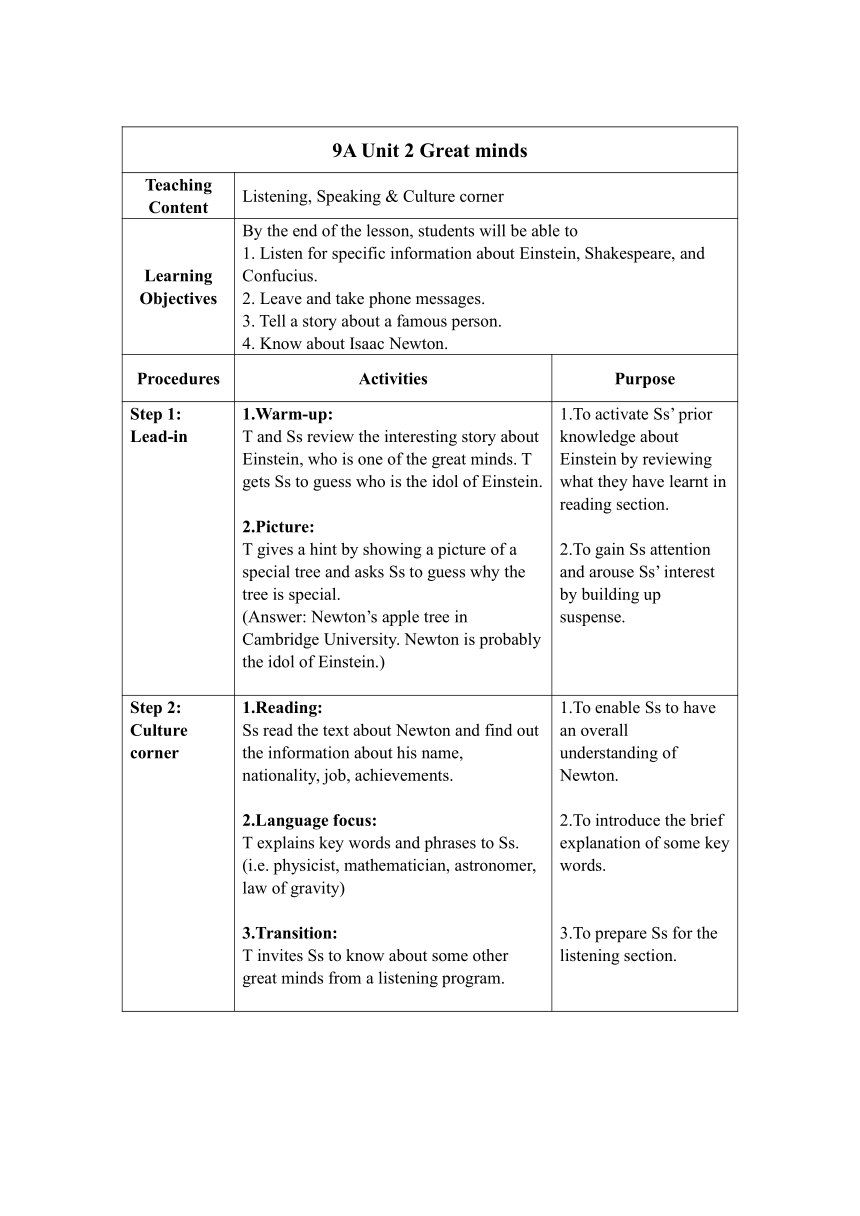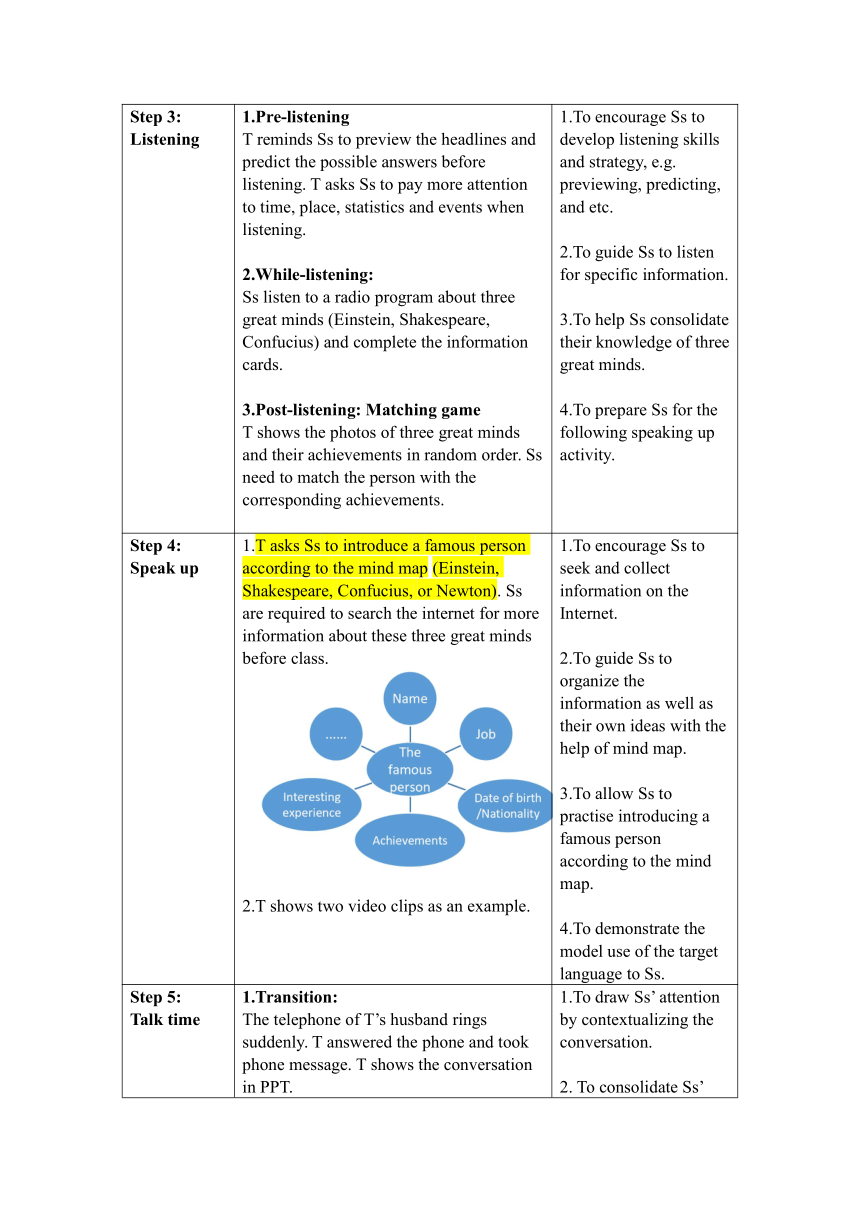牛津深圳版九年级上册 Module 1 Unit 2 Great minds. Listening,Speaking and Culture corner 表格式教案
文档属性
| 名称 | 牛津深圳版九年级上册 Module 1 Unit 2 Great minds. Listening,Speaking and Culture corner 表格式教案 |

|
|
| 格式 | docx | ||
| 文件大小 | 53.9KB | ||
| 资源类型 | 教案 | ||
| 版本资源 | 牛津深圳版 | ||
| 科目 | 英语 | ||
| 更新时间 | 2022-08-15 15:46:06 | ||
图片预览


文档简介
9A Unit 2 Great minds
Teaching Content Listening, Speaking & Culture corner
Learning Objectives By the end of the lesson, students will be able to 1. Listen for specific information about Einstein, Shakespeare, and Confucius. 2. Leave and take phone messages. 3. Tell a story about a famous person. 4. Know about Isaac Newton.
Procedures Activities Purpose
Step 1: Lead-in 1.Warm-up: T and Ss review the interesting story about Einstein, who is one of the great minds. T gets Ss to guess who is the idol of Einstein. 2.Picture: T gives a hint by showing a picture of a special tree and asks Ss to guess why the tree is special. (Answer: Newton’s apple tree in Cambridge University. Newton is probably the idol of Einstein.) 1.To activate Ss’ prior knowledge about Einstein by reviewing what they have learnt in reading section. 2.To gain Ss attention and arouse Ss’ interest by building up suspense.
Step 2: Culture corner 1.Reading: Ss read the text about Newton and find out the information about his name, nationality, job, achievements. 2.Language focus: T explains key words and phrases to Ss. (i.e. physicist, mathematician, astronomer, law of gravity) 3.Transition: T invites Ss to know about some other great minds from a listening program. 1.To enable Ss to have an overall understanding of Newton. 2.To introduce the brief explanation of some key words. 3.To prepare Ss for the listening section.
Step 3: Listening 1.Pre-listening T reminds Ss to preview the headlines and predict the possible answers before listening. T asks Ss to pay more attention to time, place, statistics and events when listening. 2.While-listening: Ss listen to a radio program about three great minds (Einstein, Shakespeare, Confucius) and complete the information cards. 3.Post-listening: Matching game T shows the photos of three great minds and their achievements in random order. Ss need to match the person with the corresponding achievements. 1.To encourage Ss to develop listening skills and strategy, e.g. previewing, predicting, and etc. 2.To guide Ss to listen for specific information. 3.To help Ss consolidate their knowledge of three great minds. 4.To prepare Ss for the following speaking up activity.
Step 4: Speak up 1.T asks Ss to introduce a famous person according to the mind map (Einstein, Shakespeare, Confucius, or Newton). Ss are required to search the internet for more information about these three great minds before class. 2.T shows two video clips as an example. 1.To encourage Ss to seek and collect information on the Internet. 2.To guide Ss to organize the information as well as their own ideas with the help of mind map. 3.To allow Ss to practise introducing a famous person according to the mind map. 4.To demonstrate the model use of the target language to Ss.
Step 5: Talk time 1.Transition: The telephone of T’s husband rings suddenly. T answered the phone and took phone message. T shows the conversation in PPT. 2.Language focus: T summarizes how to leave and take phone message by focusing on the key expressions in the conversation. 3.Consolidation: T provides a context for Ss and asks Ss to make a dialogue based on this context. (Context: You want to remind your classmate Betty that there will be a story-telling competition next Monday. However, Betty cannot answer your call because she is out at the moment. Luckily, Betty’s mother offers to take phone message for you. Please make a dialogue between you and Betty’s mother.) 1.To draw Ss’ attention by contextualizing the conversation. 2. To consolidate Ss’ knowledge about taking and leaving phone messages by explicit explanation. 3.To urge Ss to practise taking and leaving message in a meaningful and purposeful context.
Step 6: Summary (Self-assessment) T asks Ss to recall what they learn today and complete the self-assessment rubric one by one. I know about Issac Newton.I can listen for specific information about Einstein, Shakespeare, and Confucius.I can tell a story about a famous person according to the mind map.I can leave and take phone messages.
1.To invite Ss to recall and summarize the lesson together. 2.To encourage Ss to evaluate their learning and behavior, which can develop Ss’ learning autonomy in long-term.
Step 7: Homework Speech: Introduce a famous person that you admire most to the class. You can collect information in the internet and organize your introduction with a mind map. Role play: Practise taking and leaving phone message with your classmates. You can imagine a context creatively. Please take a short video to record your speech or role play. 1.To provide more opportunities for Ss to practice the target language.
Teaching Content Listening, Speaking & Culture corner
Learning Objectives By the end of the lesson, students will be able to 1. Listen for specific information about Einstein, Shakespeare, and Confucius. 2. Leave and take phone messages. 3. Tell a story about a famous person. 4. Know about Isaac Newton.
Procedures Activities Purpose
Step 1: Lead-in 1.Warm-up: T and Ss review the interesting story about Einstein, who is one of the great minds. T gets Ss to guess who is the idol of Einstein. 2.Picture: T gives a hint by showing a picture of a special tree and asks Ss to guess why the tree is special. (Answer: Newton’s apple tree in Cambridge University. Newton is probably the idol of Einstein.) 1.To activate Ss’ prior knowledge about Einstein by reviewing what they have learnt in reading section. 2.To gain Ss attention and arouse Ss’ interest by building up suspense.
Step 2: Culture corner 1.Reading: Ss read the text about Newton and find out the information about his name, nationality, job, achievements. 2.Language focus: T explains key words and phrases to Ss. (i.e. physicist, mathematician, astronomer, law of gravity) 3.Transition: T invites Ss to know about some other great minds from a listening program. 1.To enable Ss to have an overall understanding of Newton. 2.To introduce the brief explanation of some key words. 3.To prepare Ss for the listening section.
Step 3: Listening 1.Pre-listening T reminds Ss to preview the headlines and predict the possible answers before listening. T asks Ss to pay more attention to time, place, statistics and events when listening. 2.While-listening: Ss listen to a radio program about three great minds (Einstein, Shakespeare, Confucius) and complete the information cards. 3.Post-listening: Matching game T shows the photos of three great minds and their achievements in random order. Ss need to match the person with the corresponding achievements. 1.To encourage Ss to develop listening skills and strategy, e.g. previewing, predicting, and etc. 2.To guide Ss to listen for specific information. 3.To help Ss consolidate their knowledge of three great minds. 4.To prepare Ss for the following speaking up activity.
Step 4: Speak up 1.T asks Ss to introduce a famous person according to the mind map (Einstein, Shakespeare, Confucius, or Newton). Ss are required to search the internet for more information about these three great minds before class. 2.T shows two video clips as an example. 1.To encourage Ss to seek and collect information on the Internet. 2.To guide Ss to organize the information as well as their own ideas with the help of mind map. 3.To allow Ss to practise introducing a famous person according to the mind map. 4.To demonstrate the model use of the target language to Ss.
Step 5: Talk time 1.Transition: The telephone of T’s husband rings suddenly. T answered the phone and took phone message. T shows the conversation in PPT. 2.Language focus: T summarizes how to leave and take phone message by focusing on the key expressions in the conversation. 3.Consolidation: T provides a context for Ss and asks Ss to make a dialogue based on this context. (Context: You want to remind your classmate Betty that there will be a story-telling competition next Monday. However, Betty cannot answer your call because she is out at the moment. Luckily, Betty’s mother offers to take phone message for you. Please make a dialogue between you and Betty’s mother.) 1.To draw Ss’ attention by contextualizing the conversation. 2. To consolidate Ss’ knowledge about taking and leaving phone messages by explicit explanation. 3.To urge Ss to practise taking and leaving message in a meaningful and purposeful context.
Step 6: Summary (Self-assessment) T asks Ss to recall what they learn today and complete the self-assessment rubric one by one. I know about Issac Newton.I can listen for specific information about Einstein, Shakespeare, and Confucius.I can tell a story about a famous person according to the mind map.I can leave and take phone messages.
1.To invite Ss to recall and summarize the lesson together. 2.To encourage Ss to evaluate their learning and behavior, which can develop Ss’ learning autonomy in long-term.
Step 7: Homework Speech: Introduce a famous person that you admire most to the class. You can collect information in the internet and organize your introduction with a mind map. Role play: Practise taking and leaving phone message with your classmates. You can imagine a context creatively. Please take a short video to record your speech or role play. 1.To provide more opportunities for Ss to practice the target language.
